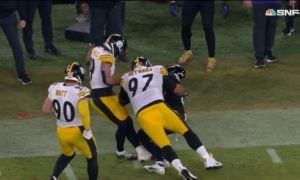Yesterday, I wrote about a pretty obvious trend that the Pittsburgh Steelers are in the process of undergoing, in which they are becoming a team that is increasingly reliant on their offensive prowess to get them through games.
Last season was, perhaps, the true tipping point between offense and defense, during which the Steelers still found success, going 11-5 and winning the division, despite the defense being a question mark for nearly the duration of the year.
Though the Steelers seem set to dedicate nearly their entire draft to sprucing up the defensive side of the ball, with an emphasis of pass rushers and cornerbacks, it seems that, by and large, the engine that will drive this team for the next five years will be the success or failure of the Ben Roethlisberger-led offense, which posted the second-best points per game average in franchise history in 2014.
The organization just committed a total of up to $108 million to their franchise quarterback over that duration, which is now the beginning of the ticking clock that counts down the time left for Pittsburgh’s championship window, for all intents and purposes.
But while the offense is filled with both talent and potential, it is not a finished product yet. There is one area in particular in which the Steelers must improve in order to field a championship-caliber offense, and that is red zone production.
A subsidiary of the above critique would be consistency, which has been a huge issue as well, but is also tied into failures in the red zone. The offense struggled against poor teams and on the road a year ago. Those aspects must not be their downfall again.
Last year, the Steelers ran 166 red zone plays, split between 103 passing attempts and 63 rushing attempts. 17.5 percent of these plays produced a touchdown, 29 in total, while six resulted in an interception or a fumble.
Roethlisberger completed 56 of 99 pass attempts for a completion percentage of 56.6, throwing for 371 yards, 20 touchdowns, and three interceptions, for a quarterback rating of 91.8, which are good, but not great numbers. A few exceptional games, such as his five red zone touchdown passes against the Colts, skew the figure.
Le’Veon Bell took 44 of the Steelers’ red zone carries, gaining 138 yards for 3.14 yards per attempt, with six touchdowns. As a team, Pittsburgh only averaged 2.56 yards per carry inside the 20, which includes LeGarrette Blount’s 2.27 yards per carry.
Looking at some of the numbers reveals how consistency is an issue. They ran 13 plays in the red zone against the New York Jets and failed to get into the end zone. In two games against the Cleveland Browns, 20 red zone plays yielded just one touchdown.
The red zone play did generally improve during the year, but the Steelers still finished 19th in terms of red zone percentage. There was an unsurprising correlation between red zone percentage and success, when looking at the rankings. If Pittsburgh doesn’t start climbing this mountain, they’ll have a hard time scaling to the top of the league in the championship game at the end of the year.








